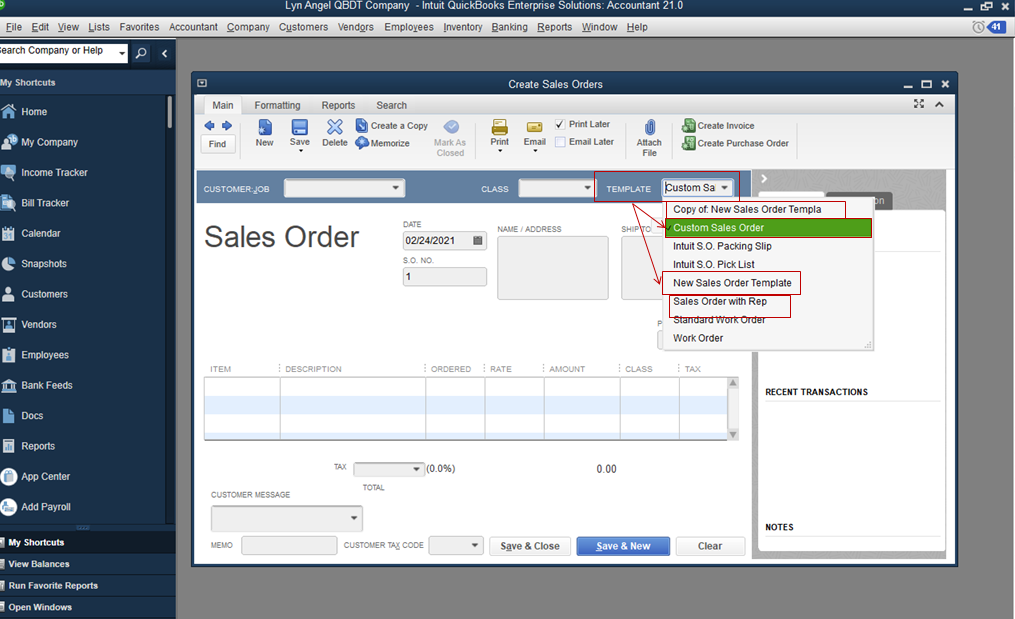How to handle sales orders in QuickBooks

Handling sales orders in QuickBooks involves efficiently managing customer orders from inception to fulfillment, ensuring accurate tracking and timely invoicing. This comprehensive guide covers everything you need to know about setting up, processing, and managing sales orders in QuickBooks.
1. Understanding Sales Orders in QuickBooks
A. What is a Sales Order?
A sales order is a document issued by a business to a customer, indicating the products or services they intend to purchase. Unlike invoices, sales orders do not record revenue or affect accounts receivable until they are converted into invoices.
B. When to Use Sales Orders
1. Pre-Sale Document
- Used to capture customer orders before invoicing.
- Confirms product availability and delivery details.
2. Order Fulfillment
- Guides inventory management and fulfillment processes.
- Tracks customer commitments and delivery timelines.
2. Setting Up Sales Orders in QuickBooks
A. Enable Sales Orders Feature
1. QuickBooks Online
- Go to “Settings” > “Account and Settings.”
- Select “Sales” > “Sales form content” > “Customize” > “Custom transaction numbers.”
- Check “Use sales forms.”
2. QuickBooks Desktop
- Go to “Edit” > “Preferences.”
- Select “Sales & Customers” > “Company Preferences.”
- Check “Enable Sales Orders.”
B. Customize Sales Forms
1. Sales Order Template
- Customize sales order templates to include relevant fields (e.g., customer information, order details).
- Go to “Custom Form Styles” > “New Style” > “Sales Order.”
3. Creating and Managing Sales Orders
A. Create Sales Orders
1. QuickBooks Online
- Go to “+ New” > “Sales Order.”
- Enter customer details, items ordered, quantities, and delivery instructions.
2. QuickBooks Desktop
- Go to “Customers” > “Create Sales Orders.”
- Enter customer details, items ordered, quantities, and shipping information.
B. Tracking Sales Orders
1. Status Updates
- Monitor sales order status (e.g., pending, fulfilled, partially fulfilled).
- Update order progress as items are picked, packed, and shipped.
4. Converting Sales Orders to Invoices
A. Convert to Invoice
1. QuickBooks Online
- Go to “Sales Orders” > Select the sales order > “Create Invoice.”
- Review details and adjust if needed before finalizing.
2. QuickBooks Desktop
- Go to “Customers” > “Sales Orders.”
- Select the sales order > “Create Invoice.”
- Edit invoice details and save.
B. Partial Invoicing
1. Partial Fulfillment
- Invoice for partial shipment if not all items are available.
- Update quantities and adjust invoice amounts accordingly.
5. Inventory Management
A. Inventory Tracking
1. Stock Availability
- Deduct inventory quantities as sales orders are fulfilled.
- Monitor stock levels to prevent overselling.
2. Backorders
- Track backordered items and notify customers of delays.
- Manage customer expectations and provide updates.
6. Reporting and Analysis
A. Sales Order Reports
1. QuickBooks Online
- Go to “Reports” > “Sales” > “Sales by Customer Summary.”
- Customize reports to view sales order status and fulfillment metrics.
2. QuickBooks Desktop
- Go to “Reports” > “Sales” > “Sales by Customer Detail.”
- Generate detailed reports on sales orders and invoicing activities.
B. Performance Analysis
1. Order Fulfillment Metrics
- Analyze order processing times and fulfillment accuracy.
- Identify bottlenecks and streamline operations.
7. Best Practices for Handling Sales Orders
A. Timely Processing
1. Order Confirmation
- Confirm orders promptly to secure customer commitment.
- Provide estimated delivery dates to manage expectations.
B. Communication
1. Customer Updates
- Notify customers of order status changes (e.g., fulfillment, shipment).
- Address inquiries and resolve issues proactively.
C. Workflow Optimization
1. Integration with Inventory Management
- Sync sales orders with inventory systems for real-time updates.
- Automate order fulfillment processes to minimize manual errors.
8. Troubleshooting and Support
A. Handling Issues
1. Order Discrepancies
- Resolve discrepancies between sales orders and invoices.
- Adjust inventory records and reconcile transactions.
B. QuickBooks Support
1. Technical Assistance
- Contact QuickBooks Support for assistance with sales order management.
- Visit the QuickBooks Support website for troubleshooting guides and resources.
C. Community Forums
1. User Community
- Engage with the QuickBooks Community for insights and advice.
- Discuss sales order management strategies and solutions with other users.
9. Conclusion
Efficiently handling sales orders in QuickBooks is essential for maintaining smooth operations and customer satisfaction in retail businesses. By following this comprehensive guide, businesses can streamline order processing, improve inventory management, and enhance financial visibility through accurate reporting and analysis. Leveraging QuickBooks’ features for sales order management ensures that businesses can meet customer demands effectively while optimizing internal processes for growth and profitability.




